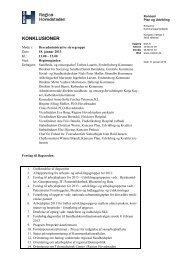Territorial Review Copenhagen - Region Hovedstaden
Territorial Review Copenhagen - Region Hovedstaden
Territorial Review Copenhagen - Region Hovedstaden
Create successful ePaper yourself
Turn your PDF publications into a flip-book with our unique Google optimized e-Paper software.
243<br />
over 1980-2003, confirm the presence of significant agglomeration effects at<br />
the aggregate level; their estimated elasticity is 13%. Cross-section<br />
regressions suggest that the strength of agglomeration effects has increased<br />
over time (1980-2003).<br />
Urban competitiveness has only become more relevant over the last<br />
decades, thanks to several factors. Trends towards the cheapening of<br />
transport and communications have continued. Rather than reducing the<br />
importance of locational assets, they have tended to stress their importance.<br />
Empirical work of Gaspar and Glaeser (1998) suggests that<br />
telecommunications may be a complement to, or at least not a strong<br />
substitute for, cities and face-to-face interactions. They show for example<br />
that people who live in metropolitan areas of more than 4 million inhabitants<br />
in the United States spend significantly more on telephones than people in<br />
smaller cities. They also show a strong correlation between urbanisation and<br />
phone use. At the same time, increasing importance has been attached to<br />
competition in terms of distinctive product qualities (more than simply<br />
price). The major effect has been to increase the importance of the more<br />
qualitative sort of urban assets. Increased global trade flows have augmented<br />
the position of urban areas as central nodes in global supply chains.<br />
Economic restructuring has made the role of urban areas more<br />
important. This is for example evidenced by the effects of mergers and<br />
acquisitions. Rodriguez-Pose and Zademach (2003) studied the geography<br />
of mergers and acquisitions in Germany during the 1990s and found that<br />
mergers and acquisitions are fundamentally large-city phenomena and<br />
contribute to the economic take-off of the main German metropolitan areas.<br />
The wave of mergers and acquisitions in the 1990s has contributed to a<br />
major concentration of firms, company headquarters and economic activity<br />
in the key German metropolitan areas. The transactions taking place in the<br />
main German cities far outweigh in relative terms all those taking place in<br />
other regions. Demographic changes such as smaller households, dualearner<br />
households, busier life-styles, increasing mobility and expansion of<br />
demand for higher education also favoured cities.<br />
Trade-offs in urban competitiveness<br />
Although there is some relation between competition on different<br />
markets, these forms of competition do not necessarily reinforce each other:<br />
being attractive as a location for new businesses does not automatically<br />
imply attractiveness for new inhabitants. This means that places have to<br />
make choices as to their priorities and choose their specific policies and<br />
competitive strategies with an awareness of their relevance to the markets<br />
most important for their success. Product market competition will typically

















